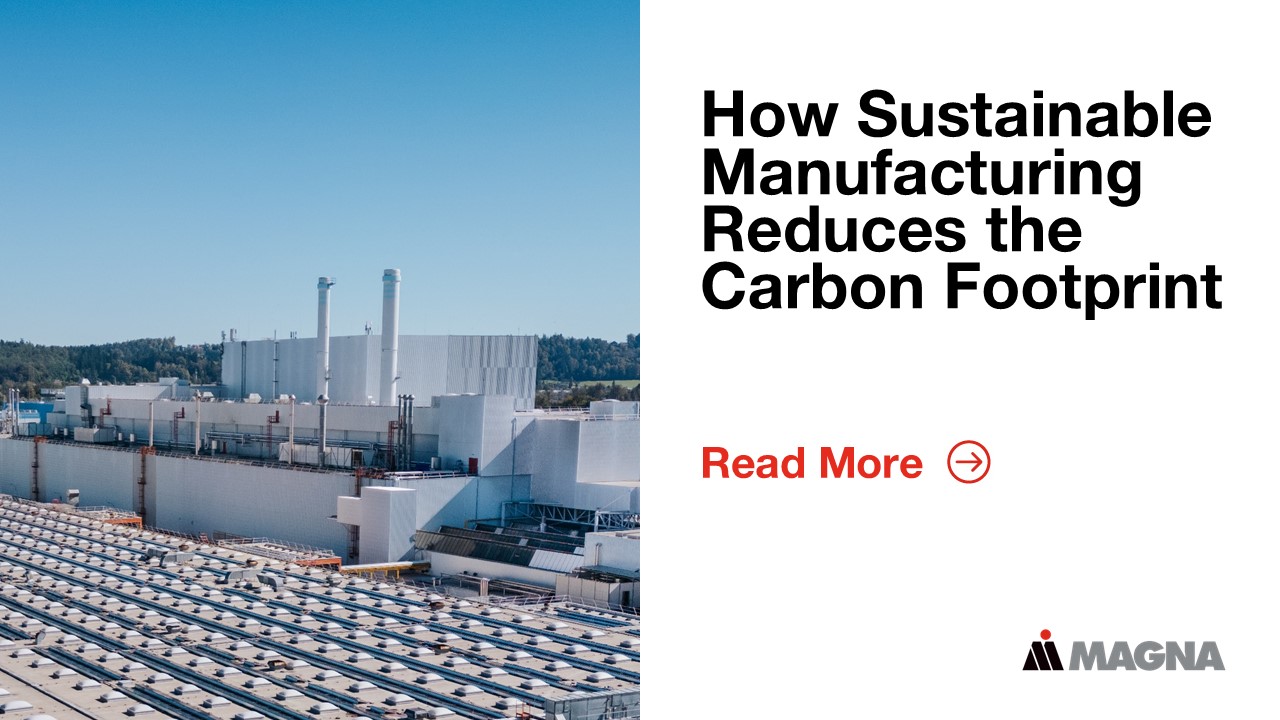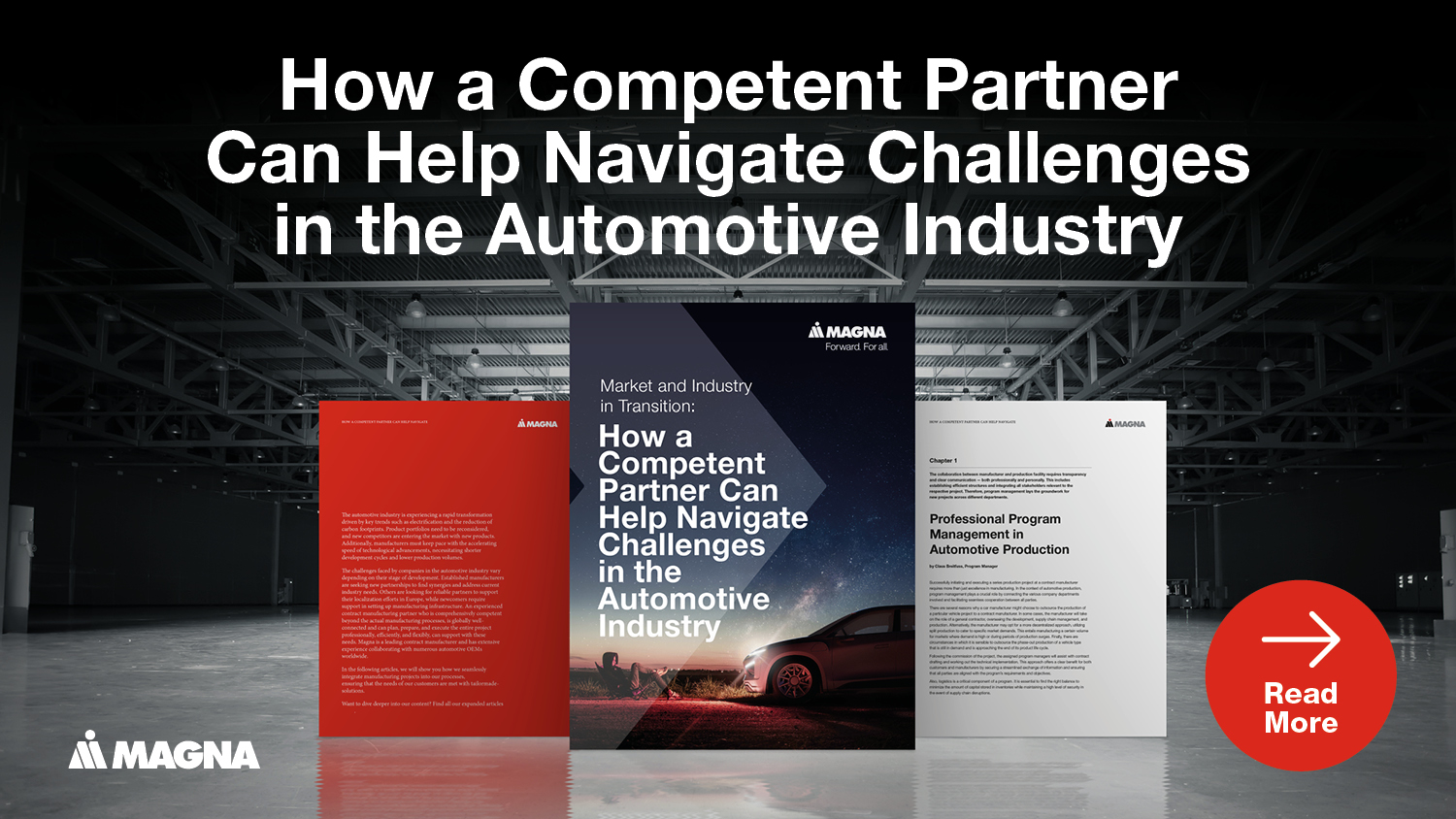
CHANGED VIEW OF SUSTAINABILITY: FROM A THANKLESS SECONDARY TASK TO A CENTRAL ELEMENT
The term ESG (Environment,
Social and Corporate Governance; referring to environmental, sustainability and
social issues) began to gain popularity twenty years ago. Since 2004, these
aspects have also been defined by the United Nations and linked to the Sustainable
Development Goals (SDGs).
Twenty years ago, the achievement of ESG goals was still
considered more of a minor task in corporate management, but today they are an
integral component and equally important objectives for companies. Back then,
it would have been bizarre to ask for a budget for beehives, for example. However,
today it is completely normal to spend money on reducing soil sealing or
donations for tree planting.
THE UN'S SUSTAINABLE DEVELOPMENT GOALS IN SUSTAINABLE MANUFACTURING
Years ago, Magna had already selected seven priority SDGs that are relevant for green automotive production from the 17 goals defined by the UN. The first is SDG 3, Good Health and Well-being. This area includes topics such as health services for employees, medical check-ups, an occupational health center, ergonomics programs, burnout prevention, flexible working time models, etc. In other words, it encompasses everything that has to do with maintaining the health of employees.
Another important topic is SDG 4: Quality Education. Training and further education opportunities, apprenticeships, cooperation with educational and research institutions, improvements to the work-life balance and even company daycare centers are all measures that are important to comprehensively sustainable corporate management.
SDG 5 is about gender equality. Magna has an important initiative underway regarding this topic, which also covers SDG 10 (Reduced Inequalities) and is aimed at diversity and inclusion. There is an employee charter and a code of conduct and ethics that is binding for all employees and is communicated in corresponding training courses. Salaries in line with the market are also laid out in this charter, as are equal opportunities regardless of origin, religion, gender and other characteristics.
SDG 9 (Industry, Innovation and Infrastructure), SDG 12 (Responsible Consumption and Production) and SDG 13 (Climate Action) are other important aspects that influence business decisions regarding sustainable manufacturing and corporate governance.
CHANGE OF PRIORITIES IN ENVIRONMENTAL PROTECTION
Efforts to achieve sustainable manufacturing are not new in the automotive industry. With reducing emissions, resource-, energy-, and material-efficiencies, waste and water management, the battle has always been fought on many fronts, so to speak. The management of waste and water has now reached an extraordinarily high level – not only at Magna, but in the industry as a whole. As such, these topics are currently fading into the background.
Now, the central focus is on avoiding emissions. Changes are underway here, particularly to reduce CO2e emissions. This is why resource efficiency is an enduring theme in green automotive production. On the one hand, it reduces negative environmental impacts. On the other hand, it also has a direct influence on economic efficiency and the profitability of the company.
ENVIRONMENTALLY FRIENDLY PRODUCTION STARTS AT THE DEVELOPMENT STAGE
However, efforts to maximize resource efficiency are not limited to the actual production processes. They must be implemented throughout the entire supply chain. Efforts are made to minimize the use of new resources and increase the proportion of recycled materials wherever possible without compromising quality, even as early as the product and component development stage.
CO2 EMISSIONS ARE NOT THE ONLY LIFETIME-RELEVANT ENVIRONMENTAL IMPACT
From an overall perspective, it is not enough to focus solely on CO2 emissions. Numerous other harmful substances must also be taken into account, both during vehicle operation and during (component) production. It is not always helpful to just look at the individual vehicle, but to understand the big picture. The type of vehicle in question also plays an important role.
The focus is changing with the transformation of automotive technology. Naturally, resource consumption for battery production is becoming increasingly important for electrified drives. Materials such as rare earths are increasingly being used with the rise of more and more electronics and the extraction of raw materials is of great importance for sustainable manufacturing. It is simply impossible to calculate all these factors down to the individual vehicle.
SCOPE 1, SCOPE 2, SCOPE 3 – DIRECT AND INDIRECT EMISSIONS IN AUTOMOTIVE PRODUCTION
A distinction is made between three types of emission sources along the value chain. The allocation of emissions to these three scopes is usually based on the Greenhouse Gas Protocol (GHG). This protocol defines standards for measuring and managing greenhouse gas emissions.
The direct emissions – Scope 1 – are the emissions caused directly by the processes in production, i.e. those caused within the plant. Indirect emissions from energy generated outside the plant, such as electricity, steam, heating and cooling – Scope 2 – include the infrastructure energy consumed. These are things like the forms of energy used for heating, ventilation or air conditioning and lighting.
The scope of emissions in the Scope 3 category - other indirect emissions - is very broad. It includes emissions caused by the manufacture of purchased goods and services, the transportation and use of manufactured products, and the handling and disposal of waste. For example, emissions caused by business travel fall into this category.
Sustainable manufacturing can certainly contribute to further reduction here as well, through the choice of purchased energy sources, for example. If green electricity is purchased, it naturally causes fewer emissions than electricity from coal-fired power plants. If business trips are cut back or carried out using more environmentally friendly means of transportation, these emissions can also be significantly decreased. Cooperation between all departments is crucial to reducing the company's overall CO2 footprint.
HOW SUSTAINABLE MANUFACTURING CAN INFLUENCE THE OVERALL EMISSIONS BALANCE
At the same time, the influence of actual manufacturing on the overall emissions balance is relatively small. Over 90 percent of the emissions burden from production at Magna comes from the purchase of goods and services and the operation of products, i.e. from the Scope 3 area. Manufacturing itself only accounts for 4 to 4.5% of emissions.
Nevertheless, these emissions should not be neglected. One way to reduce them is to make commuting as environmentally friendly as possible. How do employees get to and from work? Several measures have already been implemented at the Graz site, from an annual ticket for public transport to job bicycles and bicycle parking facilities at the most frequently used entrances to the site.
Energy savings regarding idle power or standby outside of production times should not be overlooked either. Every kilowatt hour that can be saved in unnecessary energy consumption is a gain for the environment and the economy. The potential for further emission savings is quite small, even in green automobile production. At best, it is a matter of decimal places – but here, too, every opportunity should be exploited.
MAJOR SAVINGS POTENTIAL IN THE SUPPLY CHAIN AND PRODUCT DEVELOPMENT
As mentioned, there is significant potential in the supply chains. At Magna, cross-group expert teams have been set up to explore all possibilities and implement them as quickly as possible. Of course, sustainable supply logistics is also an important factor here. And every further product development that results in reduced emissions during vehicle operation is a step towards reducing the company's overall footprint. Here too, a group of Magna experts is fiercely driving forward product development with the aim of establishing a genuine circular economy in the long term.
CHALLENGES AND OBSTACLES IN THE IMPLEMENTATION OF SUSTAINABLE MANUFACTURING
Of course, a company cannot always realize all conceivable possibilities immediately. In many cases, the necessary investment costs are a barrier. This is because the introduction of environmentally friendly technologies is expensive, mainly because demand is currently high, which is driving up prices even further.
In many cases, switching to more environmentally friendly processes leads to a complex avalanche of additional measures and testing. If you change operating material, everything from storage to disposal must be checked for possible interactions.
There are also simply technological limits in other areas. Often a theoretically possible technology is not yet available or not yet industrialized. Ultimately, employees are also crucial to the successful implementation of sustainable manufacturing and processes. If there is resistance to change, this can have a negative impact on the outcome. Employee training and motivation programs to raise awareness are therefore essential.
Last but not least, legal and normative regulations can also be an obstacle to the implementation of new, more environmentally friendly methods and processes. Of course, there are new regulations that help and others that tend to hinder. An old regulation that is still in effect may prevent the implementation of innovations that are actually desirable.
For example: Why is a truck only allowed to tow one trailer and not two or three over defined distances, as long as the weight limits are adhered to avoid damaging the roads? Unfortunately, despite repeated requests, there is no leeway with the legislation.
ADVANTAGES OF GREEN AUTOMOTIVE PRODUCTION AT THE CONTRACT MANUFACTURER FOR OEMS
As a contract manufacturer, a company like Magna does not act in isolation, but always in the interests of its customers, i.e. the vehicle manufacturers. These manufacturers also benefit directly from sustainable production. By creating sustainable manufacturing processes, customers can achieve their corporate goals in terms of environmental compatibility and social responsibility.
Efforts to improve energy management and reduce energy intensity are directly reflected in lower production costs. A decrease of these costs is also in the interest of the vehicle manufacturer. In addition, it can boost the manufacturer's image if production is carried out exclusively with green electricity. Some vehicle manufacturers explicitly demand this, knowing that it will improve the overall image of their end products.
REDUCING THE CO2 BURDEN ALSO IN THE INTERESTS OF THE END CUSTOMER
When assessing vehicle-related emissions, it is fortunately becoming more acceptable to consider the direct emissions during operation, as well as those over the entire life cycle of the vehicle. In fact, every product, including every car, comes with a CO2 burden even before it is used for the first time. If it is transparent how much energy and how many emissions are contained in the end product, the consumer can also decide which CO2 burden to choose. In this respect, resource-conserving and low-emission production is also a competitive advantage for the OEM.
FUTURE TRENDS IN VEHICLE PRODUCTION IN THE INTEREST OF GREATER SUSTAINABILITY
Efforts to decarbonize mobility and therefore decarbonize vehicle production will undoubtedly continue. Even if this goal cannot be achieved in full in the next few years, it will remain on the agenda in the long term. Other trends that are emerging are efforts to extend product lifetimes, including improving reparability. This aspect can and will have a significant impact on automotive manufacturing.
This change is also continuing with materials. The trend towards aluminum to reduce the weight of finished vehicles is already underway. As a result, the number of new joining techniques in addition to traditional welding will also increase.
And of course, the digitalization of production through Industry 4.0 will continue to advance and bring about change. This can also improve sustainable manufacturing by saving material and energy through digital process optimization.
Stay connected with Inside Automotive!

We want to hear from you
Send us your questions, thoughts and inquiries or engage in the conversation on social media.
Related Stories
Successfully Starting Series Production: Start-up Management in the Automotive Industry
Inside Automotive
Strategy and Prototyping in UI/UX Development for Vehicle Control Concepts on Behalf of Customers
Inside Automotive
Professional Risk Management and Financing in Automotive Serial Production
Inside Automotive
The IT Challenges for a Contract Manufacturer in the Automotive Industry
Inside Automotive
Stay connected
You can stay connected with Magna News and Stories through email alerts sent to your inbox in real time.



.tmb-widescreen.webp?sfvrsn=8d57edff_1)


